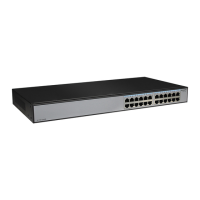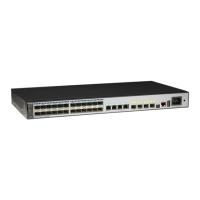#
vlan batch 40
#
interface Vlanif40
ip address 172.16.1.2 255.255.255.0
#
interface XGigabitEthernet0/0/1
port trunk allow-pass vlan 40
#
ospf 1
area 0.0.0.1
network 172.16.1.0 0.0.0.255
stub
#
return
4.14.3 Example for Configuring an OSPF NSSA Area
Networking Requirements
As shown in Figure 4-7, OSPF is enabled on all Switches and the entire AS is partitioned into
three areas. SwitchA and SwitchB function as ABRs to forward routes between areas. SwitchD
functions as the ASBR to import external routes (static routes).
The requirement is to configure Area 1 as an NSSA area and configure SwitchC as an ASBR to
import external routes (static routes). The routing information can be transmitted correctly in
the AS.
Figure 4-7 Configuring OSPF NSSA areas
Switch A
Switch C
Switch D
Switch E
Switch F
Area 0
Area 1
Area 2
Switch B
XGE 0/0/2
XGE 0/0/2
XGE 0/0/2
XGE 0/0/2
XGE 0/0/1
XGE 0/0/1
XGE 0/0/1 XGE 0/0/1
XGE 0/0/1
XGE 0/0/1
S-switch
Interface VLANIF Interface IP Address
SwitchA XGE 0/0/1 VLANIF 10 192.168.0.1/24
SwitchA XGE 0/0/2 VLANIF 20 192.168.1.1/24
SwitchB XGE 0/0/1 VLANIF 10 192.168.0.2/24
SwitchB XGE 0/0/2 VLANIF 30 192.168.2.1/24
SwitchC XGE 0/0/1 VLANIF 20 192.168.1.2/24
S6700 Series Ethernet Switches
Configuration Guide - IP Routing 4 OSPF Configuration
Issue 01 (2012-03-15) Huawei Proprietary and Confidential
Copyright © Huawei Technologies Co., Ltd.
147

